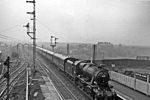Broadhurst Park

Broadhurst Park is a football ground in Moston, Manchester, England. It is the home of F.C. United of Manchester and Moston Juniors F.C. The ground was known by its project name, Moston Community Stadium, before being changed at a members' meeting in 2014. F.C. United formed in 2005, and aimed to construct a ground in Manchester by 2012. After plans for an initial site collapsed, the development of a new ground in Moston was announced. A protracted planning process followed, and construction began in November 2013. Broadhurst Park was completed with a capacity of 4,400 in May 2015. The opening match was a friendly between F.C. United and Benfica on 29 May 2015. F.C. United played host to Stockport County in their first ever competitive league match at Broadhurst Park on 11 August 2015.
Excerpt from the Wikipedia article Broadhurst Park (License: CC BY-SA 3.0, Authors, Images).Broadhurst Park
The Boardwalk, Manchester Moston
Geographical coordinates (GPS) Address Nearby Places Show on map
Geographical coordinates (GPS)
| Latitude | Longitude |
|---|---|
| N 53.5167 ° | E -2.1804 ° |
Address
The Boardwalk
M40 0FJ Manchester, Moston
England, United Kingdom
Open on Google Maps









